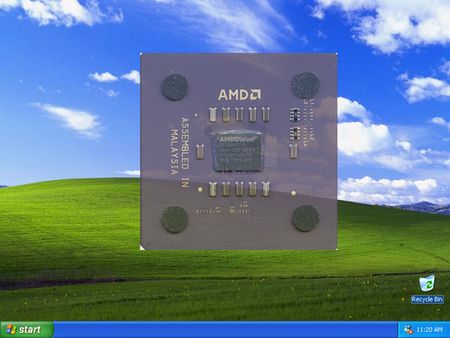Imitation To Innovation: AMD's Best CPUs
Duron and Sempron: AMD's Celerons
CPU makers seem to like names that end in “on.” To compete with the Celeron and back up its Athlon, AMD released the Duron, later replaced by the Sempron. These two budget processors were generally slower than the Athlon and had less cache memory. AMD’s exclusive cache design enabled CPUs with an L2 cache that was smaller than the L1, since the latter was not mirrored in the L2 (unlike the inclusive architecture used by Intel). The Sempron is simply a re-named Athlon XP, with certain versions equipped with less cache memory (256 of 512 KB are disabled in the Thorton).
| Code name | Spitfire | Thorton |
| Date released | 2000 | 2004 |
| Architecture | 32-bits | 32-bits |
| Data bus | 32-bits | 32-bits |
| Address bus | 32-bits | 32-bits |
| Maximum memory | 4,096 MB | 4,096 MB |
| L1 cache | 64 KB + 64 KB | 64 KB + 64 KB |
| L2 cache | 64 KB (CPU frequency) | 256 KB (CPU frequency) |
| Clock frequency | 600-950 MHz | 1,500-2,000 MHz |
| FSB | 100 MHz (DDR) | 166 MHz (DDR) |
| FPU | built-in | built-in |
| SIMD | MMX, Enhanced 3DNow! | MMX, Enhanced 3DNow!, SSE |
| Fabrication process | 180 nm | 130 nm |
| Number of transistors | 25 million | 54.3 million |
| Power consumption | 27-41 W | 62 W |
| Voltage | 1.5–1.6 V | 1.6 V |
| Die surface area | 100 mm² | 100.99 mm² |
| Connector | Socket A | Socket A |
In addition to the Spitfire, AMD also released the Duron Morgan (based on the Athlon XP, with SSE support) and the Applebred (130 nm). The Sempron continued its career with the K8 Sempron 3400+, which is a 64-bit Sempron.
Get Tom's Hardware's best news and in-depth reviews, straight to your inbox.
Current page: Duron and Sempron: AMD's Celerons
Prev Page AMD Improves the Athlon: Thunderbird, XP, and more. Next Page The K8: AMD Moves To 64 Bits-
cpuTweaker Lackluster article...a lot of backround on the chips were left out, fact that make thier acomplishments truely impressive. To THG's credit, their was at least some mention of the impact Alpha had on some of the chip designs, but no where near being complete.Reply
Where the intel article seemed to overshadow intel's little victories, this article seems to gloss over AMD innovation (though i'll admit that i didn't recall the bit about the Intel chip, either the pentium or pentium pro, that gave incorrect values for mathmatical equations)
Both articles really need alot more detail added. As i've actually ranted about the history i'm reffering to in the comments section of the intel article as well as many other's i won't re-hash it. -
neiroatopelcc Despite not being terribly detailed, I still like these recaps. Good articles really, all of them. Now all we need is one on alpha, and on how the mac stuff went before it was called intelReply -
neiroatopelcc Oh and on ati I suppose, seeing we've already had nvidia :9 ... or even matrox, 3dfx and others that have vanished in a combo article...Reply
This is like viasat history - only more specific and technical -
AMD 386 SX @25 MHz was powering my first personal computer. The whole computer costed ~4000$ and it wasn't even top performance.Reply
AMD 486 @120 Mhz was making my friends that bought an early Pentium red with envy.
-
jj463rd I had several systems with the AMD 486 X5 processor at 133 Mhz.I also have 2 K6-2 systems,1 Athlon a Athlon 64 and a Phenom X4 9850 BE system.Actually most of my systems are Intel basedthough.When I first heard that AMD was in pretty big trouble I still wouldn't get a B2 Phenom but when they fixed the bug I decided to help them out by building the Phenom X4 9850BE system which runs very well.Plus I've just ordered some new ATI graphics cards too.Reply
Someone gave me a AMD K5 system.
Thanks for the article. -
Malovane Heh, owned one AMD processor of every line, starting with the 8086 and ending with the Phenom. Wasn't even intentional for the first decade, but I'm glad I did. Liked the article, though it could have gone into a bit more detail and back story.Reply -
Minerva I enjoy these articles as well, as I collect old hardware...Reply
I have quite a few chips from both makers, including the AMD 40MHz 386, and an Intel 386 & 387 33MHz cpu's, which are quite scarce... -
NightLight I too collect old hardware Minerva, in fact, I still have a lot of them still in running order on a mainboard ! Good Review, I just loved to see that windows 3 series again :)Altough a little bit biased...Reply
